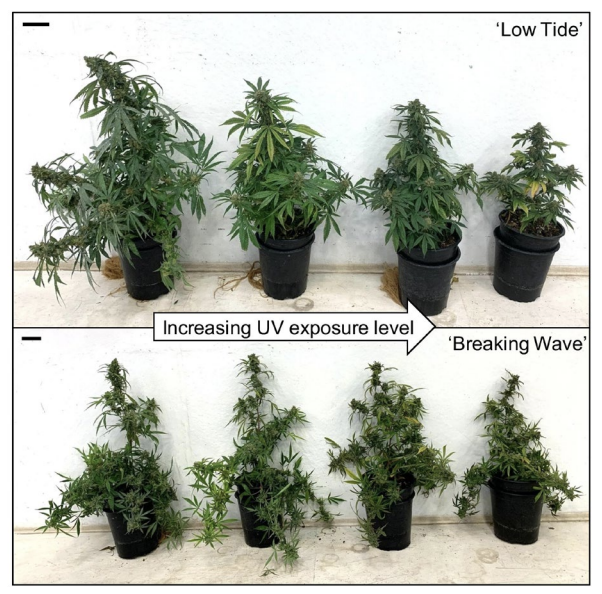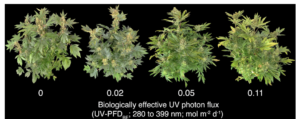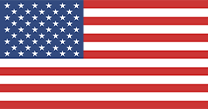
January 7, 2025
Ultraviolet (UV) radiation is often touted as an effective tool to increase cannabinoid production in cannabis cultivation. The premise is that UV acts as an environmental stressor, triggering plants to produce secondary metabolites like cannabinoids and terpenes as a protective mechanism. However, while UV stress has been shown to influence the synthesis of compounds like flavonoids and phenolics in some plant species, and cannabinoids do absorb UV radiation, recent research examining the effect of increasing UV in cannabis cultivation has consistently demonstrated that UV exposure has a negligible or negative impact on cannabinoid concentrations.
Understanding UV Radiation
UV radiation is the region of the electromagnetic spectrum with shorter wavelengths and higher energy than photosynthetically active radiation (PAR) and visible light. It is divided into three categories:
- UV-A (315–400 nm): The least energetic, it penetrates deeper into tissues and can influence photomorphogenic responses but causes minimal damage in most plants[1].
- UV-B (280–315 nm): A mid-energy radiation that induces DNA damage and stress responses, leading to the activation of repair mechanisms and secondary metabolite pathways[2].
- UV-C (100–280 nm): The most energetic and harmful, UV-C is filtered by the Earth’s atmosphere and is not encountered under natural sunlight. UV-C lamps are commonly used to sterilize surfaces and minimize powdery mildew[3].
Among these, UV-B is most often studied for its role in inducing stress responses in plants. It can stimulate the production of protective compounds like flavonoids, but its effect on cannabis-specific metabolites such as cannabinoids remains controversial.
Theoretical Basis for UV and Cannabinoid Production
Cannabis is a prolific producer of secondary metabolites, including cannabinoids, terpenes, and flavonoids[4]. Cannabinoids such as THC and CBD are hypothesized to function as UV shields, absorbing harmful radiation to protect underlying tissues[5]. Cannabinoids absorb UV radiation, and this idea has led to the assumption that increased UV exposure might lead to elevated cannabinoid production. UV-B is known to trigger metabolic pathways related to the biosynthesis of secondary compounds in plants, such as the phenylpropanoid pathway, which produces flavonoids[6]. However, the effect of UV on cannabis remained largely unexplored until recently due to prohibition.
Experimental Results: A Mixed Picture
Despite the theoretical basis, experimental studies have largely failed to confirm a significant impact of UV radiation on cannabinoid production:
1. Minor Increase in THC:
- Lydon et al. (1987)[7] reported a small (less than 10%) increase in THC concentration with increasing UV-B in a drug-type variety. However, the total THC concentration of flowers at that time was less than 3% (30 mg g-1). These findings provided early evidence that UV-B may influence THC biosynthesis in low-cannabinoid genotypes, but the authors concluded that: The contribution of cannabinoids as selective UV-B filters is equivocal. Despite this conclusion, this study fueled decades of belief that UV-B is the silver bullet for increasing cannabinoid concentration under electric lighting.
2. No Effect on CBD or THC:
- Rodriguez-Morrison et al. (2021)[8]: This study investigated the effects of UV-B radiation (0.01–0.8 μmol m–² s–¹) on two type II (equal CBD:THC) cannabis cultivars grown indoors. Increasing UV-B exposure reduced photosynthesis, leaf size, and caused stigma browning. However, cannabinoid concentrations (THC or CBD) did not increase and, in one variety, decreased slightly. The authors concluded that UV-B offers no commercially relevant benefits for enhancing cannabinoids in cannabis inflorescence.
- Llewellyn et al. (2022)[9]: This research examined both UV-A (50 μmol m–² s–¹) and combined UV-A + UV-B (3 μmol m–² s–¹) treatments in type I (high-THC) cultivars. While UV exposure caused no significant impact on total THC/CBD concentrations, a slight increase in sugar leaf THC was observed under UV A + UV-B. The overall findings emphasized that UV light did not enhance commercially relevant cannabinoid production.
- Westmoreland et al. (2023)[10]: This study explored high UV photon fluxes (including UV-B and UV-A) on a type III (high-CBD) cultivar. There was no effect of UV on cannabinoid concentration across a wide range of daily UV doses (Figure 1). The authors concluded that UV light is ineffective for increasing cannabinoids in high-cannabinoid cultivars.

3. Reduced Plant Growth and Yield:
- Rodriguez-Morrison et al. (2021)[8]: The authors observed a decrease in total dry inflorescence yield in one of the two cultivars (“Low Tide”) as UV-B exposure increased. The reduction in yield was attributed to UV induced leaf curling that reduced photon capture and reduced photosynthesis.
- Westmoreland et al. (2023)[10]: At the highest UV treatment levels, flower yield was reduced by 12%. The reduction was associated with increased chlorosis (Figure 2) and physiological stress caused by elevated UV photon fluxes, including a reduction in canopy photosynthesis. It is worth noting that the reduction in yield was small, and the daily UV dose was exceptionally high, suggesting that cannabinoid do act as UV filters, but additional UV exposure has not been shown to increase cannabinoid concentration in high cannabinoid varieties.

Practical Implications for Growers
Given the current body of evidence, growers should weigh the following considerations when deciding whether to incorporate UV into their cultivation practices:
1. Energy Costs and Efficiency:
- UV-B and UV-A LEDs have low efficacy, often below 1.0 µmol/J1, compared to 2.5–3.0 µmol/J for modern full-spectrum LEDs[11].
- Fluorescent UV lights are even less efficient and require frequent replacements, further driving up operational costs.
- With no consistent cannabinoid gains, the added energy costs does not justify adding UV.
2. Potential for Plant Damage:
- Elevated UV can cause morphological changes that can reduce photon capture, photosynthesis, and yield.
3. Health and Safety Risks:
- UV radiation poses risks to human health, including skin damage and eye injuries. Proper safety equipment, such as UV-blocking eyewear and shielding, adds complexity and cost.
4. Focus on Proven Strategies:
- Optimizing photosynthetically active radiation (PAR), temperature, CO₂ enrichment, and genetics remains the most reliable strategy for improving yield and cannabinoid production.
Conclusion
Despite the theoretical appeal of using UV radiation to increase cannabinoid production, current research does not support its effectiveness as a reliable cultivation strategy. While UV-B can induce stress responses in plants, its impact on cannabinoids is inconsistent and often offset by reductions in yield. Growers are better served by focusing on proven techniques such as optimizing light intensity, photoperiod, and genetics to maximize both yield and cannabinoid concentration.
References
- Zhen, S., Kusuma, P. & Bugbee, B. Photons at the ultraviolet-visible interface: Effects on leaf expansion and photoinhibition. Scientia Horticulturae 326, 112785 (2024).
- Jenkins, G. I., Christie, J. M., Fuglevand, G., Long, J. C. & Jackson, J. A. Plant responses to UV and blue light: biochemical and genetic approaches. Plant Science 112, 117–138 (1995).
- Janisiewicz, W. J. et al. Use of low-dose UV-C irradiation to control powdery mildew caused by Podosphaera aphanis on strawberry plants. Canadian Journal of Plant Pathology 38, 430–439 (2016).
- Andre, C. M., Hausman, J.-F. & Guerriero, G. Cannabis sativa: The Plant of the Thousand and One Molecules. Front. Plant Sci. 7, (2016).
- Pate, D. W. Possible role of ultraviolet radiation in evolution ofCannabis chemotypes. Economic Botany 37, 396 (1983).
- Mackerness, S. A.-H.-. Plant responses to ultraviolet-B (UV-B: 280–320 nm) stress: What are the key regulators? Plant Growth Regulation 32, 27–39 (2000).
- Lydon, J., Teramura, A. H. & Coffman, C. B. UV-B radiation effects on photosynthesis, growth, and cannabinoid production of two Cannabis saitva chemotypes. Photochemistry and Photobiology 46, 201–206 (1987).
- Rodriguez-Morrison, V., Llewellyn, D. & Zheng, Y. Cannabis Inflorescence Yield and Cannabinoid Concentration Are Not Increased With Exposure to Short-Wavelength Ultraviolet-B Radiation. Frontiers in Plant Science 12, (2021).
- Llewellyn, D. et al. Indoor grown cannabis yield increased proportionally with light intensity, but ultraviolet radiation did not affect yield or cannabinoid content. Front Plant Sci 13, 974018 (2022).
- Westmoreland, F. M., Kusuma, P. & Bugbee, B. Elevated UV photon fluxes minimally affected cannabinoid concentration in a high-CBD cultivar. Frontiers in Plant Science 14, (2023).
- Kusuma, P., Pattison, P. M. & Bugbee, B. From physics to fixtures to food: current and potential LED efficacy. Horticulture Research 7, 1–9 (2020).




